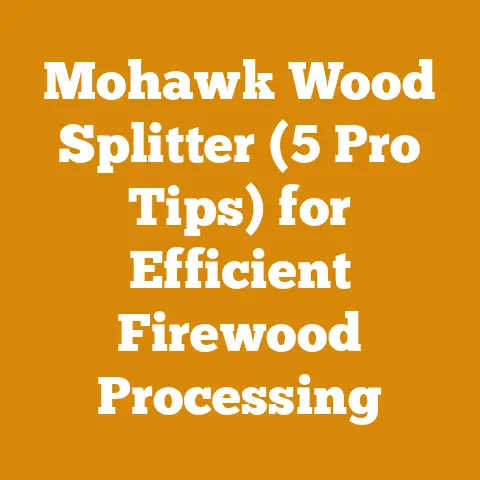Is Poplar a Good Firewood? (Indoor Fireplace Insights)
I remember the first time I considered poplar for firewood. It was late autumn, and my usual stash of seasoned oak was dwindling faster than expected. A neighbor was taking down a massive poplar tree, and the offer of free wood was too tempting to resist. But a nagging question lingered: is poplar a good firewood, especially for my indoor fireplace? That question sent me down a rabbit hole of research, experimentation, and, ultimately, a deeper understanding of what makes good firewood.
Is Poplar a Good Firewood? (Indoor Fireplace Insights)
Poplar, often overlooked in favor of its denser hardwood cousins, has a place in the firewood landscape. However, it’s crucial to understand its properties and limitations to make informed decisions about its suitability for your indoor fireplace. Let’s dive into the heart of the matter.
Understanding Poplar: A Woodworker’s Perspective
Before we throw poplar logs into the fire, let’s take a closer look at the tree itself. Poplar belongs to the Populus genus, which includes a variety of species like quaking aspen, cottonwood, and hybrid poplars. These trees are known for their rapid growth, making them a common sight in many regions.
Wood Anatomy and Properties
Poplar is a softwood, although the term can be misleading. It simply refers to the tree’s botanical classification, not necessarily its density or hardness. Here’s a breakdown of its key characteristics:
- Density: Poplar is relatively low in density compared to hardwoods like oak or maple. This means it weighs less per unit volume.
- Moisture Content: Freshly cut poplar has a high moisture content, often exceeding 60%. This is a critical factor when considering it for firewood.
- Heat Value (BTU): Due to its lower density, poplar has a lower BTU (British Thermal Unit) rating than hardwoods. BTU measures the amount of heat released when burning. Expect around 12.6 million BTU per cord for air-dried poplar.
- Burning Characteristics: Poplar burns quickly and produces a relatively short-lived fire. It also tends to produce more smoke than hardwoods, especially if not properly seasoned.
- Splitting: Poplar is generally easy to split, especially when green. This can be a significant advantage for those who split their firewood manually.
Poplar Varieties
While all poplars share some common traits, there are differences between species. Cottonwood, for example, tends to be softer and less dense than hybrid poplars. Aspen, also a poplar, is slightly denser than cottonwood. Knowing the specific type of poplar you’re dealing with can help you better predict its burning characteristics.
The Firewood Factor: Hardwood vs. Softwood
The debate between hardwoods and softwoods for firewood is a long-standing one. Here’s a simple comparison:
| Feature | Hardwood | Softwood |
|---|---|---|
| Density | High | Low |
| BTU Value | High | Low |
| Burn Time | Long | Short |
| Smoke Production | Low (when seasoned) | High (especially when unseasoned) |
| Resin Content | Low | High (in some species like pine) |
| Splitting | Can be difficult, especially when knotty | Generally easy, especially when green |
Hardwoods, like oak, maple, and ash, are the gold standard for firewood. They provide long-lasting heat and produce less smoke when properly seasoned. Softwoods, like pine and fir, are often used as kindling due to their ease of ignition. Poplar falls somewhere in between.
Seasoning Poplar: The Key to Success
Seasoning, or drying, firewood is crucial regardless of the species. It reduces the moisture content, making the wood easier to ignite, burn more efficiently, and produce less smoke.
Why Seasoning Matters
- Improved Combustion: Dry wood burns hotter and more completely, releasing more heat and less creosote.
- Reduced Smoke: High moisture content leads to incomplete combustion, resulting in excessive smoke.
- Creosote Reduction: Creosote is a flammable byproduct of burning unseasoned wood. It can accumulate in your chimney and pose a significant fire hazard.
- Easier Ignition: Dry wood ignites much faster and easier than wet wood.
Seasoning Techniques
- Stacking: Stack the wood in a single row, off the ground, with good air circulation. This allows the wind and sun to dry the wood evenly.
- Location: Choose a sunny and windy location for your woodpile.
- Covering: Cover the top of the woodpile to protect it from rain and snow, but leave the sides open for airflow.
- Time: Poplar typically needs at least 6-12 months of seasoning to reach an acceptable moisture content (around 20%).
I’ve found that using a moisture meter is invaluable for determining when the wood is ready to burn. Simply split a few pieces and measure the moisture content on a freshly exposed surface.
Poplar Seasoning: A Case Study
I conducted a small experiment with poplar firewood seasoning. I split a cord of freshly cut poplar and divided it into two groups. One group was stacked in a sunny, windy location, while the other was stacked in a more shaded area. After six months, the poplar in the sunny location had a moisture content of around 18%, while the shaded poplar was still above 30%. This highlights the importance of proper stacking and location.
Burning Poplar in Your Indoor Fireplace: Considerations
Now, let’s address the main question: is poplar a good firewood for your indoor fireplace? The answer is nuanced.
Pros of Burning Poplar
- Easy to Split: This is a major advantage for those who split their own firewood.
- Quick to Dry: Poplar dries relatively quickly compared to denser hardwoods.
- Readily Available: Poplar is often abundant and can be a cost-effective option, especially if you can get it for free or at a low price.
- Good for Shoulder Seasons: Poplar is ideal for those times of year when you need a quick burst of heat but don’t want a long-lasting fire.
Cons of Burning Poplar
- Low Heat Output: Poplar doesn’t produce as much heat as hardwoods, so you’ll need to burn more of it to achieve the same level of warmth.
- Short Burn Time: Poplar burns quickly, requiring frequent reloading of the fireplace.
- Higher Smoke Production: Poplar tends to produce more smoke than hardwoods, especially if not properly seasoned. This can be a concern for indoor air quality.
- Creosote Buildup: Burning unseasoned poplar can contribute to creosote buildup in your chimney, increasing the risk of a chimney fire.
- Sparking: Some poplar species can spark more than other firewood types.
Mitigating the Cons
- Proper Seasoning: This is the most important factor. Ensure the poplar is thoroughly seasoned before burning it.
- Mixing with Hardwoods: Combine poplar with hardwoods to extend burn time and increase heat output.
- Chimney Maintenance: Regularly inspect and clean your chimney to prevent creosote buildup. I recommend doing this at least once a year, or more frequently if you burn a lot of wood.
- Fireplace Screen: Use a fireplace screen to contain any sparks.
- Airflow Control: Adjust the airflow in your fireplace to optimize combustion and reduce smoke.
Safety First: Carbon Monoxide Awareness
Regardless of the type of firewood you burn, carbon monoxide (CO) is a serious concern. CO is a colorless, odorless gas that can be deadly.
- Install CO Detectors: Place CO detectors on every level of your home, especially near sleeping areas.
- Proper Ventilation: Ensure your fireplace is properly vented and that the chimney is clear of obstructions.
- Never Burn Wood in an Unvented Appliance: This is extremely dangerous and can lead to CO poisoning.
Logging Tools and Techniques: From Tree to Firewood
If you’re harvesting your own poplar for firewood, you’ll need the right tools and techniques.
Chainsaw Selection and Maintenance
The chainsaw is the primary tool for felling trees and bucking logs.
- Size and Power: Choose a chainsaw that is appropriate for the size of the trees you’ll be cutting. A 16-18 inch bar is a good all-around size for firewood cutting.
- Safety Features: Look for features like a chain brake, anti-vibration system, and throttle interlock.
- Maintenance: Regularly sharpen the chain, clean the air filter, and check the bar oil level. A dull chain is not only inefficient but also dangerous.
- Personal Protective Equipment (PPE): Always wear a helmet, eye protection, hearing protection, gloves, and chainsaw chaps when operating a chainsaw.
Felling Techniques
Felling a tree safely requires careful planning and execution.
- Assess the Tree: Look for signs of weakness, such as dead branches or a leaning trunk.
- Plan Your Escape Route: Identify a clear path away from the falling tree.
- Make the Notch Cut: This cut determines the direction of the fall.
- Make the Back Cut: This cut is made on the opposite side of the tree, slightly above the notch cut.
- Use Wedges: If the tree doesn’t start to fall on its own, use wedges to help push it over.
Splitting Wood: Manual vs. Hydraulic
Splitting wood can be a physically demanding task. You have two main options: manual splitting with an axe or maul, or using a hydraulic log splitter.
- Manual Splitting: This is a good option for smaller quantities of wood or for those who enjoy the physical challenge. A maul is heavier than an axe and is better suited for splitting larger rounds.
- Hydraulic Log Splitter: This is a more efficient option for splitting large quantities of wood. Log splitters come in various sizes and power levels. Consider the size of the logs you’ll be splitting when choosing a log splitter.
I’ve used both manual and hydraulic splitters. For smaller jobs, I prefer the exercise of manual splitting. But when I have a large pile of wood to process, the hydraulic splitter saves me a lot of time and energy.
Project Planning and Execution: A Firewood Strategy
Creating a sustainable firewood supply requires careful planning.
Estimating Your Needs
- Heating Requirements: Determine how much firewood you need to heat your home based on your climate, the size of your home, and the efficiency of your fireplace.
- Wood Availability: Assess the availability of firewood in your area. Can you harvest your own wood, or will you need to purchase it?
- Storage Space: Ensure you have enough space to store your firewood properly.
Creating a Seasoning Schedule
- Cut and Split Early: Cut and split your firewood in the spring or early summer to give it ample time to season before winter.
- Rotate Your Stock: Use the oldest, driest wood first.
- Plan Ahead: Always have a year’s worth of firewood seasoned and ready to burn.
Cost-Benefit Analysis
Consider the costs and benefits of different firewood options.
- Free Wood: Harvesting your own wood can be the cheapest option, but it requires time, effort, and the right equipment.
- Purchased Wood: Buying firewood can be more expensive, but it saves you time and effort. Compare prices from different suppliers and ask about the wood’s moisture content.
Poplar Firewood: Real-World Examples and Insights
Over the years, I’ve gathered some interesting insights from my own experiences and from other wood burners.
Case Study 1: Poplar in a Wood Stove
A friend of mine uses poplar as his primary firewood in his wood stove. He lives in a mild climate and finds that poplar provides enough heat for his needs. He seasons it for at least a year and mixes it with some hardwood for longer burn times. He also cleans his chimney regularly to prevent creosote buildup.
Case Study 2: Poplar as Shoulder Season Fuel
Another friend uses poplar exclusively during the shoulder seasons (spring and fall). He finds that it’s perfect for taking the chill out of the air without overheating the house. He appreciates that it dries quickly and is easy to handle.
A Unique Poplar Insight
I discovered that poplar ash makes a surprisingly good garden amendment. It’s rich in potassium and other minerals that can benefit plants. Just be sure to use it sparingly, as it can raise the pH of the soil.
Conclusion: Making the Right Choice
So, is poplar a good firewood for your indoor fireplace? The answer depends on your individual circumstances. If you have access to free or inexpensive poplar, are willing to season it properly, and don’t mind the shorter burn time and lower heat output, it can be a viable option, especially when mixed with hardwoods or used during the shoulder seasons. However, if you live in a cold climate and rely heavily on your fireplace for heat, you may want to stick with denser hardwoods.
Ultimately, the best firewood is the one that is readily available, affordable, and meets your specific needs. By understanding the properties of different wood species and following proper seasoning and burning practices, you can enjoy the warmth and ambiance of a wood-burning fireplace safely and efficiently.
Actionable Advice:
- If you’re considering using poplar for firewood, start by testing a small amount to see how it performs in your fireplace.
- Invest in a moisture meter to ensure your firewood is properly seasoned.
- Regularly inspect and clean your chimney to prevent creosote buildup.
- Always prioritize safety when operating chainsaws and splitting wood.
Now, go forth and conquer that woodpile!






